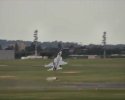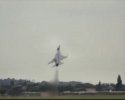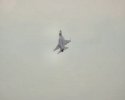You are using an out of date browser. It may not display this or other websites correctly.
You should upgrade or use an alternative browser.
You should upgrade or use an alternative browser.
JF-17/FC-1 Fighter Aircraft thread
- Thread starter johnqh
- Start date
The /Pakistan Aeronautical Complex JF-17 Thunder fighter has secured its first confirmed export deal.
“A contract has been signed with an Asian country,” says Air Commodore Khalid Mahmood, the Pakistan air force officer who leads sales and marketing efforts for the type.
Citing client sensitivities, he declined to specify the customer and the number of aircraft it will obtain. Deliveries will start in 2017.
He says that sales for the JF-17, which is targeted for developing nations, have been held up by political turmoil in several Middle Eastern countries.
The aircraft is making its flying debut at this year’s air show. Pakistan’s air force has brought three examples this year. One will appear on the static display, one will appear in the flying display, and the third will serve as a backup.
The JF-17 contingent at this year is 80 strong, representing a significant marketing push. Khalid says the show is a good venue for meeting prospective customers from French speaking countries.
He says that 11 countries are looking at the type, which mirrors previous comments made by Chinese defence export agency Catic, which also markets the aircraft, and Pakistan air force officials.
Khalid also provided an update of Pakistan’s induction of the type. So far, 54 examples have been delivered. The first 50 were originally delivered in a Block I configuration, and these are in the process of being updated to a Block II standard. The Block II configuration features improved avionics and better software, and adds a fixed air-to-air refuelling probe.
An additional 46 aircraft will be delivered in the Block II configuration. A subsequent 50 aircraft, which will push Pakistan’s fleet to 150 examples, will have a Block III configuration. These will all be delivered by the end of 2018.
The aircraft’s developers are still working out the specifications of the Block III aircraft, but upgrades could include an active electronically scanned array (AESA) or Passive electronically scanned array (PESA) radar, says Khalid. The configuration could also include an infrared search and track (IRST) sensor, stations under the forward fuselage for various pods, and expanded precision weapons capabilities.
A two-seat variant is also planned, which will serve mainly as a trainer. Pakistan produces 58% of the airframe and China 42%. The JF-17 is powered by a single Klimov RD-93 engine.
@denio @asif iqbal
Last edited by a moderator:
My guess is myanmar because there were reports that they are close to signing a deal.Interesting !!!
Any guess what country this could be ??
My guess is myanmar because there were reports that they are close to signing a deal.
I surely hope not. They'll probably use against China again, inadvertent or not.
You are probably right in the 2nd sentence. But KSA (Kingdom of Saudi Arabia?) and Iran are indeed Asian countries geographically and in Chinese terms they are western Asian countries even though Chinese also use the term middle-east, but then middle-east in Chinese sense is just west Asia plus Egypt.He said Asian, so IMO middle east is out (Egypt/KSA/Iran). Hence, most probably one of the following Bangladesh/Myanmar/Srilanka...
SinoSoldier
Colonel
I realize that airshow displays aren't exactly the best gauge for pilot skill, but China needs to send its pilots to Pakistan for training.
thunderchief
Senior Member
Pilot showed a lot of skill , and there was a considerable risk . JF-17 with RD-93 is well below T/W of 1 even empty , therefore plane started decelerating as soon it was airborne . Yet it was still stable enough to apply left rudder and slowly straighten itself .



